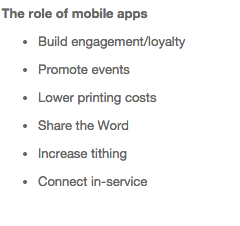 EDITOR’S NOTE: Today, we hear from Santiago Jaramillo, CEO and Founder of mobile app developer Bluebridge. We recently partnered with Bluebridge to co-author a guide for churches to understand Mobile Technology and the Church. The following post is based on an excerpt from the book, highlighting the importance of a cohesive church mobile strategy that includes both apps and responsive websites.
EDITOR’S NOTE: Today, we hear from Santiago Jaramillo, CEO and Founder of mobile app developer Bluebridge. We recently partnered with Bluebridge to co-author a guide for churches to understand Mobile Technology and the Church. The following post is based on an excerpt from the book, highlighting the importance of a cohesive church mobile strategy that includes both apps and responsive websites.
The church has historically been a trailblazer when it comes to technology. That’s right—the church. To echo the sentiments of Brandon Cox of pastors.com, churches have traditionally been early adopters of modern technology, but have fallen short in the current age. Take the Gutenberg press, which used the bible as its prototype, prompting the mass adoption of print media by churches. Then there was broadcast journalism, which coincided with the church’s modern expansion and start of many church broadcasts, which are some of the longest-running programs on today.

But when it comes to modern digital technologies like mobile devices, why are churches slow to adopt?
As the world’s fastest-adopted method of communication, the mobile device continues to grow in usership. Today, mobile accounts for over 55% of all web traffic. And for the first time in history, Americans spent more time on their smartphones last year than watching TV. (Flurry) Think this mobile thing is catching on?
Mobile growth is only expected to rise. According to Forrester Research, the number of global mobile smartphone users will reach 3.5 billion by 2019. With that, mobile apps and responsive websites are on the fast track to becoming the preferred channel for consuming information.
Know what that means? God’s message isn’t changing. But the method of sharing it is.
So where do today’s churches fall in the adoption cycle?
3 Ways Churches Adapt to Technology
-
Line in the Sand. Churches go “prehistoric” and decide they won’t adopt new technology.
-
Resist and Hold. Churches resist new technology as long as possible, then adopt it only to find they are already behind in innovation.
-
Address and Adapt. Churches recognize patterns in technology usage and directly address them within the church.
Regardless of your church’s stance, members are starting to expect a mobile presence. In fact, a study by AT&T and Ebony Magazine reveals that 90% of churchgoers say that mobile has a place in the church. In addition, Forbes asserts that 19% of American smartphone users are already checking their mobile devices during worship, while 70% of practicing Christian millennials say they use a smartphone or the internet to read scripture. (Facts & Trends) While it may seem like just another fad or distraction to your members, there’s one thing you can’t ignore—faith communities with major tech use are roughly 50% more likely to have members who actively recruit into the congregation. (Hartford Institute)

Apps and Responsive Sites
Both mobile apps and mobile responsive websites play an important role in church communications strategy. People come to your church from all walks of life—and they may not each share the same level of engagement with you just yet. So it stands that using different methods of communication will attract and retain members differently and appropriately for what they’re meant for—engagement, outreach, ministry, and relevance.










